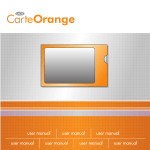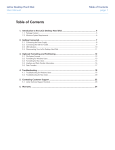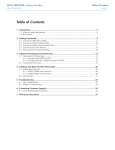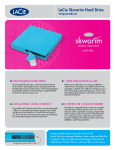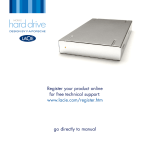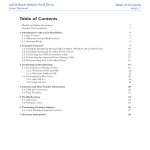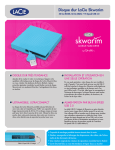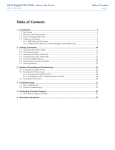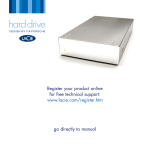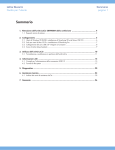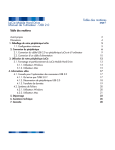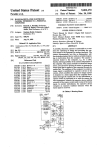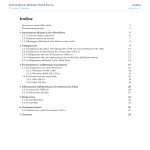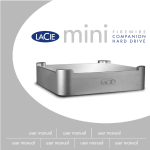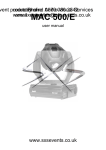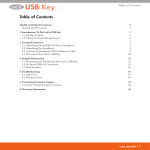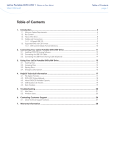Download Product Manual
Transcript
LaCie Skwarim User Manual Table of Contents page 1 Table of Contents 1. Unpacking Your LaCie SKWARIM ........................................................................... 4 1.1. Minimum System Requirements .................................................................................................. 4 2. Getting Connected .................................................................................................. 5 2.1. 2.2. 2.3. 2.4. Windows 98 SE and Windows Me Users Only: Silverlining 98 and USB 2.0 Driver Installation ........ 6 Mac OS 9.x Users Only: Silverlining Pro Installation .................................................................... 7 Connect the Integrated USB 2.0* Cable to Your Computer........................................................... 8 Launching LaCie Setup Assistant................................................................................................. 9 3. Using Your LaCie SKWARIM ................................................................................. 10 3.1. Formatting And Partitioning Your LaCie Drive ........................................................................... 11 4. Helpful Information .............................................................................................. 15 4.1. Advice For Optimizing USB 2.0 Connections ............................................................................ 15 4.2. File System Formats ................................................................................................................ 17 5.Troubleshooting ................................................................................................... 20 6. Contacting Customer Support ............................................................................... 24 6.1. LaCie Technical Support Contacts............................................................................................. 25 7.Warranty .............................................................................................................. 26 LaCie Skwarim User Manual Copyright Copyright © 2011 LaCie. All rights re served. No part of this publication may be reproduced, stored in a retrieval system, or transmitted in any form or by any means, electronic, mechanical, photocopying, re cording or otherwise, without the prior writ ten consent of LaCie. Trademarks Apple, Mac and Macintosh are registered trademarks of Apple Computer, Inc. Micro soft, Windows 98, Windows 98 SE, Win dows 2000, Windows Millennium Edition and Windows XP are registered trademarks of Microsoft Corporation. Other trade marks mentioned in this manual are the property of their respective owners. Changes The material in this document is for infor mation only and subject to change without notice. While reasonable efforts have been made in the preparation of this document to assure its accuracy, LaCie assumes no liability resulting from errors or omissions in this document, or from the use of the in formation contained herein. LaCie reserves the right to make changes or revisions in the product design or the product manual without reservation and without obligation to notify any person of such revisions and changes. Forward page 2 FCC Statement: LaCie SKWARIM Tested to comply with FCC standards for home or office use CAUTION: Modifications not authorized by the manufacturer may void the user’s authority to operate this device. NOTE: This equipment has been tested and found to comply with the limits for LaCie SKWARIM a Class A digital device, pursu ant to Part 15 of the FCC Rules. These lim its are Tested To Comply designed to provide reasonable protection against harmful interference when the interference will not occur in a particular installation. If this equipment does cause harmful interference to radio or televi sion reception, which can be determined by turning the equipment off and on, the user is encouraged to try and correct the interference by one or more of the follow ing measures: ✦✦ Reorient or relocate the receiving an tenna. ✦✦ Increase the separation between the equipment and receiver. ✦✦ Connect the equipment into an out let on a circuit different from that to which the receiver is connected. ✦✦ Consult the dealer or an experienced radio/TV technician for help. With FCC standards equipment is operated in a commercial environment. This equipment generates, uses, and can radiate radio frequency en ergy and, if not installed and used in FOR HOME OR OFFICE USE accordance with the instruction manual, may cause harmful interference to radio communications. Operation of this equip ment in a residential area is likely to cause harmful interference in which case the user will be required to correct the interference at his own expense. NOTE: This equipment has been tested and found to comply with the limits for a Class B digital device, pursuant to Part 15 of the FCC Rules. These limits are designed to provide reasonable protection against harmful interference in a residential instal lation. This equipment generates, uses and can radiate radio frequency energy and, if not installed and used in accordance with the instructions, may cause harmful inter 110427v1.2 ference to radio communications. Howev er, there is no guarantee that Canada Compliance Statement This Class A digital apparatus meets all requirements of the Canadian InterferenceCausing Equipment Regulations. Manufacturer’s Declaration for CE Certification We, LaCie, solemnly declare that this product conforms to the following Euro pean directives: 2004/108/EC (EMC), and 2006/95/EC (Safety) LaCie Skwarim User Manual Precautions Forward page 3 ✦✦ Only qualified persons are autho rized to carry out maintenance on this device. Avoid placing your drive near a heat source or exposing it to sunlight (even through a window). Placing your drive in an environment that is too cold or humid may damage the unit. ✦✦ Read this User’s Guide carefully, and follow the correct procedure when setting up the device. ✦✦ Do not use the hard drive near other electrical appliances such as televi sions, radios or speakers. ✦✦ Do not open your hard drive or at tempt to disassemble or modify it. Never insert any metallic object into the drive to avoid any risk of electrical shock, fire, short-circuiting or dan gerous emissions. Your hard drive contains no user-serviceable parts. If it appears to be malfunctioning, have it inspected by a qualified LaCie Technical Support representative. ✦✦ Do not place the drive near sources of magnetic interference, such as computer displays, televisions or speakers. Magnetic interference can affect the operation and stability of your hard drive. ✦✦ Never expose your device to rain, or use it near water, or in damp or wet conditions. Never place objects con taining liquids on the drive, as they may spill into its openings. Doing so increases the risk of electrical shock, short-circuiting, fire or personal in jury. General Use Precautions ✦✦ Do not expose the hard drive to tem peratures outside the range of 5¡ C to 35¡ C (41¡ F to 95¡ F) in oper ating mode. Doing so may dam age the drive or disfigure its casing. ✦✦ Do not place heavy objects on top of the drive or use excessive force on it. ✦✦ Never use excessive force on your drive. If you detect a problem, con sult the Troubleshooting section in this manual. ✦✦ Protect your hard drive from exces sive exposure to dust during use or storage. Dust can build up inside the device, increasing the risk of damage or malfunction. ✦✦ Never use benzene, paint thinners, detergent or other chemical products to clean the outside of the drive. Such products will disfigure and discolor the casing. Instead, use a soft, dry cloth to wipe the device. CAUTION: The drive’s warranty may be void as a result of the failure to respect the precautions listed above. This symbol on the product or on its packaging indicates that this product must not be disposed of with you other household waste. Instead, it is your responsibility to dispose of your waste equipment by handing it over to a designed collection point for the recycling of waste electrical and electronic equipment. The separate collection and recycling of your waste equipment at the time of disposal will help to conserve natural resources and en sure that it is recycled in a manner that pro tects human health and the environment. For more information about where you can drop off your waste equipment for recy cling, please contact your local city office, your household waste disposal service or the shop where you purchased the product. LaCie Skwarim User Manual 1.Unpacking Your LaCie SKWARIM The LaCie SKWARIM lets you take your office files, photos, songs and video everywhere you go. The SKWARIM fits in the palm of your hand and delivers speed and convenience in its compact, rug ged design. The LaCie SKWARIM offers plug and play performance* without the need for an interface cable or a cumbersome powersupply. 1. LaCie SKWARIM with integrated Hi-Speed USB 2.0 cable 2. USB Extension Cable LaCie Utilities and user manual are located on the drive and will appear once the LaCie Setup Assistance has been installed. For details, refer to section 2.4. Launching LaCie Setup Assistant. 1.1. Minimum System Requirements System Requirements for USB 2.0: ✦✦ Windows 98 SE, Windows 2000, Windows Me and Windows XP ✦✦ Mac OS 9.2 (Apple USB support 1.3.5 and greater) and Mac OS X Hardware Requirements for USB 2.0: ✦✦ Computer with USB 2.0 or 1.1 interface* ✦✦ G3 processor or Intel Pentium II 350MHz-compatible proces sor or greater ✦✦ Minimum 32MB RAM TECHNICAL NOTE: *To achieve USB 2.0 speeds, your drive must be connected to a USB 2.0 host port. If it is connected to a USB 1.1 port, your drive will operate at USB 1.1 speeds. For more details, see 4.1. Advice For Optimizing USB 2.0 Connections. *No driver needed for Windows 2000, Windows XP, Mac OS 9.2 and Mac OS X Unpacking Your LaCie SKWARIM page 4 LaCie Skwarim User Manual 2.Getting Connected The SKWARIM is plug & play for Windows 2000, Windows XP and Mac OS X. If you’re using one of these operating systems, move to ahead to 2.3. Connect the Integrated USB 2.0* Cable to Your Computer. Windows 98 SE and Windows Me Users: You should install the included driver software and Silverlining 98. Refer to the following installation steps. Mac OS 9.x Users: You should install the included Silverlining Pro software. Refer to the following installation steps. Once you’ve gotten the drive connected to your computer, move on to section 3. Using Your LaCie SKWARIM for important information on how to format and utilize your drive. Getting Connected page 5 LaCie Skwarim User Manual Getting Connected page 6 2.1. Windows 98 SE and Windows Me Users Only: Silverlining 98 and USB 2.0 Driver Installation To use your new LaCie drive, first install the necessary driver software and then Silverlining 98. Follow the steps below to install the neces sary drivers and software to configure your drive. Then move on to the USB 2.0 installation steps. Step 1) Insert the LaCie Storage Utilities CD-ROM in your com puter’s internal CD/DVD drive and open the disc (Fig. 01). 1. Double-click the USB 2.0 Drivers Install folder. 2. Double-click on the LaCie_USB_Driver_Install.exe icon. The LaCie USB2 Storage Driver screen will appear. Click on Next. Step 1 3. Installation will finish automatically. Step 2) Re-open the LaCie Storage Utilities CD-ROM. 1. Double-click the Silverlining 98 folder. 2. Double-click the Silverlining98_Install.EXE icon. 3. Silverlining 98 will then initialize the install screen. The “Wel come” screen will appear. Click Next. 4. The “Destination Location” screen will appear. To alter the location where the software is installed on your system, click the Browse button. If you do not want to change the location, do not click on the Browse button, and allow the software to be installed in its default location. Click Next to continue. 5. Next is the “Start Installation” screen. Click Next. 6. The software installation will begin, and you will see the instal lation screens. 7. Finally, you will see the “Silverlining 98 has been installed cor rectly” screen. Click Finish to complete the installation. Fig. 01 Step 2 LaCie Skwarim User Manual Getting Connected page 7 2.2. Mac OS 9.x Users Only: Silverlining Pro Installation Before connecting the power supply and USB 2.0 cable to your drive, you will need to install Silverlining Pro, which will help you manage your drive. Follow the steps below to install the necessary drivers and software to configure your drive. Then move on to the power supply and USB 2.0 cable installation steps. 1. Insert the LaCie Storage Utilities CD-ROM in your comput er’s internal CD/DVD drive. 2. Open the CD icon and double-click on the Silverlining Software folder. 3. Click on the Silverlining Installer icon (Fig. 02). 4. The Silverlining Utilities screen appears. Click on Continue. 5. The “Silverlining Read Me” screen appears. Read the follow ing information and click on Continue. 6. The “License Agreement” screen appears. Click on Agree. 7. The “Installation” screen appears. Choose either Easy Install, Custom Install or Uninstall from the pull-down menu in the upper left-hand side of the “Installation” screen. Once you’ve made your choice, click on Install. 8. A message appears to confirm that the installation was suc cessful. Now move onto Step 1. Fig. 02 LaCie Skwarim User Manual Getting Connected page 8 2.3. Connect the Integrated USB 2.0* Cable to Your Computer Unfold and connect the integrated Hi-Speed USB 2.0 cable to your computer (Fig. 03). After a few seconds, your LaCie drive will mount on your computer. You also may use the included USB extension cable by connecting the integrated USB 2.0 cable to it and then connecting the extension cable to your computer. Proceed to section 2.4. Launching LaCie Setup Assistant. TECHNICAL NOTE: The LaCie SKWARIM is plug & play for Win dows 2000, Windows XP and Mac OS X. Windows 98SE and Win dows Me users should install the included driver software and Silver lining 98. Fig. 03 TECHNICAL NOTE: Please refer to section 4.1. Advice For Optimizing USB 2.0 Connections for important information on disconnecting USB 2.0 devices and ensuring optimum performance. * To achieve USB 2.0 speeds, your drive must be connected to a USB 2.0 host port. If it is connected to a USB 1.1 port, your drive will operate at USB 1.1 speeds. For more details, see 4.1 Advice for Optimizing USB 2.0 Con nections. LaCie Skwarim User Manual 2.4. Launching LaCie Setup Assistant Before using your drive, LaCie Setup Assistant software must be launched to format your drive. The Setup Assistant will: ✦✦ Optimize your drive according to your needs ✦✦ Copy the manual and utilities from your drive onto your com puter It is highly advised to copy the user manual and utilities onto your computer’s internal hard drive or other medium. To launch LaCie Setup Assistant: Windows users: double click on the LaCie drive icon in “My Com puter” and then double click the LaCie Setup Assistant icon. Mac users: double click on the “LaCie Setup Assistant” icon ap pear on your desktop and then double click the LaCie Setup As sistant icon. The LaCie Setup Assistant will guide you through the process of op timizing your LaCie hard drive for your needs. IMPORTANT INFO: If you do not launch LaCie Setup Assistant or if you quit LaCie Setup Assistant after the formatting has begun, your drive will not be ready to use and will require manual formatting. The user manual and utilities will not be available on your drive and will have to be downloaded from the LaCie website: www.lacie.com TECHNICAL NOTE: The LaCie Setup Assistant does not prevent you from using your computer’s native disk utility program to format or partition your LaCie drive. Simply follow the Setup Assistant through completion, then use your computer’s native disk utility (Disk Manage ment for Windows or Disk Utility for Mac) to reformat your drive. See section 3.1. Formatting And Partitioning Your LaCie Drive for more information. Getting Connected page 9 LaCie Skwarim User Manual Using Your LaCie Skwarim page 10 3.Using Your LaCie SKWARIM Once you’ve connected your drive and it is recognized by your op erating system (i.e. Windows 98SE, Me, 2000, XP or Mac OS 9.x or 10.x), you are ready to format and partition the drive. In order to store information on a hard drive, it must have a file system and be divided into sections that will contain the data that you wish to store. This process is called formatting. In order to utilize a hard disk drive, it has to be formatted first. For matting a disk consists of the following: the operating system erases all of the bookkeeping information on the disk, tests the disk to make sure that all of the sectors are reliable, marks bad sectors (i.e., those that are scratched) and creates internal address tables that it later uses to locate information. Once formatted, the actual available storage capacity varies, depending on operating environment, and is generally about 10% less than the non-formatted capacity. IMPORTANT NOTE: The LaCie SKWARIM is preformatted in FAT 32, so if you want to use another file system, you will need to re-for mat the drive. The following information will help you decide which file system format to use. After you’ve formatted the drive, you have will the opportunity to divide the hard drive into sections, called Partitions. A partition is a section of the hard drive’s storage capacity that is created to con tain files and data. For instance, you could create three partitions on your drive: one partition for your word documents, one for your spreadsheets and one for your multi-media files. File System Formats There are essentially three different file system formats: FAT 32, NTFS, and Mac OS Extended (HFS+). Use FAT 32 if: you will be using your drive between both Windows and Mac OS 9.x or 10.x; or sharing the drive between Windows 98 SE, Me, 2000 or XP Use NTFS if: you will be using the drive only under Windows 2000 or Windows XP; performance will be generally greater when compared to FAT 32 Use HFS+ if: you will be using the drive on Macs only; performance will be generally greater when compared to FAT 32 For more information, please refer to section 4.2. File System Formats. LaCie Skwarim User Manual Using Your LaCie Skwarim page 11 3.1. Formatting And Partitioning Your LaCie Drive Once you have set-up your LaCie drive, you can reformat or parti tion it to suit your needs. 3.1.1.Windows Users ✦✦ Windows 98 SE and Me – Install and use LaCie Silverlining 98, which is included with your drive. ✦✦ Windows 2000 and XP – Use the Disk Management Utility, which is native to the operating system. For instructions on installing and using Silverlining 98, please refer to the Silverlining manual, located on your LaCie Storage Utilities CD, in PDF format. Formatting And Partitioning Using Windows 2000 And Windows XP Fig. 04 The process of formatting and partitioning a drive on a computer running Windows 2000 or Windows XP consists of two steps (Fig. 04): (1) installing a signature on the drive, and (2) partitioning/for matting the drive. These steps will erase anything that is on the disk. 1. Connect the drive to the computer via the USB 2.0 port. Rightclick My Computer and click Manage. 2. From the Computer Management window, select Disk Man agement (located below the Storage group). 3. If this is the first time the drive is being formatted, Windows 2000 will launch the Write Signature Wizard (Write Initialize Wizard in Windows XP). Click Next. 4. Windows will list the new drive(s) attached. If you are format ting a single drive, only one drive should be visible. Select the checkbox next to the drive and click Next. IMPORTANT NOTE: Check the “quick format” box. 5. Click Finish to exit the Wizard. 6. Now, with the disk management window open, a new drive will be visible. Right-click on the available space and select Create Partition...(Fig. 05). 7. This will bring up the Create Partition Wizard. Click Next. 8. Select Primary Partition. Click Next. Fig. 05 LaCie Skwarim User Manual Using Your LaCie Skwarim page 12 9. Here you must specify partition size. It is recommended that you leave the partition set to the maximum available size, un less you want multiple partitions on the same drive. Click Next. 10. Select Assign drive letter and select the desired letter for the drive. Click Next (Fig. 06). 11. Select Format this partition… and then select a file system: FAT32 is a file system that is compatible with Windows 98 SE, Win dows Me, Windows 2000 and Windows XP; however, it has limita tions. In Windows 2000 and Windows XP, you will not be able to create a partition greater than 32GB. Fig. 06 NTFS is a newer file system that is compatible only with Windows NT, Windows 2000 and Windows XP. It has fewer limitations than FAT 32 and will enable a partition to be created that is larger than 32GB. IMPORTANT NOTE: Please refer to section 4.2. File System Formats, for a more detailed discussion on the differences between the two systems. 12. Click Next. 13. Click Finish. 14. Disk Management will create the partition and begin format ting the drive. Once completed, close Disk Management and your new drive will be ready to use (Fig. 07). Fig. 07 LaCie Skwarim User Manual Using Your LaCie Skwarim page 13 3.1.2.Mac Users ✦✦ Mac OS 9.x – Install and use LaCie Silverlining Pro, which is included with your drive. ✦✦ Mac OS 10.x – Use the Apple Disk Utility application, which is native to the operating system. For instructions on installing and using Silverlining Pro, please refer to the Silverlining manual, located on your LaCie Storage Utilities CD, in PDF format. Formatting And Partitioning Using Mac OS 10.x CAUTION: Following these steps will erase anything that is on the hard drive. Therefore, if you have information that you want to pro tect or continue to use, backup this information before performing these steps. 1. Connect the drive to the computer via the USB 2.0 port. Once the drive mounts onto the desktop, go to the Menu Bar, and open Go. From the Go menu, click on Applications. 2. In the Applications menu, open the Utilities folder, and then double-click Disc Utility from the Utilities folder. 3. The Disc Utility window will open (Fig. 08). In the left side of the window will be a list of the available hard disk drives. You should see a volume that represents your internal hard drive, and one that reads LaCie. 4. Select the LaCie drive, and then click on the Partition tab. 5. From the Volume Scheme: button, choose the number of par titions you want to divide the drive into by clicking on the pull down menu starting with Current (Mac OS 10.x gives you the option of dividing the drive into at most 8 partitions). You can customize the size of the partitions by using the slide bar be tween the partitions in the Volume Scheme: area. 6. In the Volume Information section, create a name for each partition, choose the volume format (Mac OS Extended, Mac OS Standard or UNIX File System) and the volume size. IMPORTANT NOTE: Please refer to section 4.2. File System Formats, for a more detailed discussion on the differences between the two systems. IMPORTANT NOTE: Apple recommends that unless you have a specific reason to use the UNIX File System (UFS), you should use the Mac OS Extended format since it provides a more familiar experi ence to Macintosh users. Fig. 08 LaCie Skwarim User Manual 7. In the Options section, click the Install Mac OS 9 Disk Drivers box if you plan on sharing the drive between the Mac OS 9.x and Mac OS 10.x. 8. Once you have finalized the volume format, number of parti tions, size and options, click OK. The following message will appear: “Warning! Saving the new volume will erase all exist ing volumes. This can NOT be undone. Are you sure you want to do that?” Click Partition to continue. 9. Mac OS 10.x will automatically setup the disk with the parti tions and volume format you selected, and your new drive will be available for use. Using Your LaCie Skwarim page 14 LaCie Skwarim User Manual 4.Helpful Information 4.1. Advice For Optimizing USB 2.0 Connections The following technical information relates to your LaCie Drive and gives some practical advice: 4.1.1.What is USB 2.0? The new USB 2.0 standard provides higher bandwidth for highspeed peripherals such as external hard drives, high-speed scanners and CD-RW drives. USB 2.0 delivers transfer rates up to 480Mbits/s, while conveniently maintaining backward compatibility with USB 1.1 devices. USB 2.0 can still be used to connect lower-speed USB 1.1 ports and devices like digital cameras, scanners, modems, keyboards, mice, joysticks and printers. In the USB 2.0 system, existing USB periph erals do not have to be upgraded, and lower-speed devices will not require additional performance, instead operating as USB 1.1 devices. 4.1.2.USB Cables and Connectors Your LaCie drive is shipped with a USB 2.0-certified USB cable, to ensure maximum data transfer performance when connected to a USB 2.0 port. The cable will also work when connected to a USB 1.1 port, but drive performance will be limited to USB 1.1 transfer rates. There are also different types of USB connections, such as the minicable and device end. Make sure that you have the correct type of connection on computer. Consult LaCie Customer Support or your LaCie reseller for more information. 4.1.3.USB 2.0 Host Bus Adapters and Performance To utilize the newly-enhanced USB 2.0 performances, your com puter must be equipped with a USB 2.0 host bus adapter card (sold separately, such as the LaCie USB 2.0 PCI Card, or integrated by your PC manufacturer) and the appropriate drivers. These host bus adapter cards, which include one or more USB ports, are shipped with special USB 2.0 drivers that enable the computer to control the card. These drivers must be installed in order for USB 2.0 devices connected to the port to work at their correct speeds. For installation Helpful Information page 15 LaCie Skwarim User Manual Helpful Information page 16 instructions, please refer to the documentation that comes with the host adapter card. LaCie supplies only the appropriate USB 2.0 drivers for its peripher als and does not provide drivers for third-party host adapter cards. To obtain the right drivers for your host adapter card, visit your card manufacturer’s Internet site. 4.1.4.Disconnecting USB 2.0 Devices USB 2.0 external devices feature “plug & play” connection. This means that your drive can be connected and disconnected while the computer is running. To prevent failures, it is important you follow these steps when disconnecting your USB 2.0 device. Windows Users (Fig. 09 – Windows Users) IMPORTANT NOTE: Windows 98 SE Users: If you have installed the Windows Storage Supplement Update, you will have to unmount the drive before disconnecting it or powering it down. If you have not installed the update, simply disconnect the drive when it is not active. No unmounting is required. Fig. 09 – Windows Users 1. From the System Tray (located in the lower right-hand side of your screen), click on the Eject icon (a small green arrow over a hardware image). 2. A message will appear, detailing the devices that the Eject icon controls, i.e. “Safely remove…” Click on this prompt. 3. You will then be given the following message: “Safe to Re move Hardware” (or similar). It is now safe to disconnect the device. Mac Users (Fig. 10 – Mac Users) You must unmount the hard drive system before disconnecting it. 1) Drag the hard drive icon to the trash. 2) The drive can now be disconnected. Fig. 10 – Mac Users LaCie Skwarim User Manual 4.1.5.Data Transfers Data transfers are the flow of data that accomplishes a task, usu ally related to moving data from storage to computer RAM or be tween storage devices. During data transfers, it’s best to wait before launching other applications on the same USB 2.0 port. Anomalies may arise with computers that have USB 2.0 controllers* that do not conform to OHCI (Open Host Controller Interface) standards. In any other configurations, we cannot ensure 100% correct operation. Due to this, you may encounter hanging problems. If this happens, proceed as follows: 1. Make sure that the USB 2.0 cable is connected tightly and securely to the computer. 2. Disconnect the USB 2.0 cable. Wait 30 seconds. Reconnect. CAUTION: Do not connect USB 2.0 cables so that they form a ring of devices. There is no need for terminators on USB 2.0 devices, so the unused USB 2.0 connectors should be left empty. *TECH NOTE: Controller - This is a component or an electronic card (referred to in this case as a “controller card”) that enables a computer to communicate with or manage certain peripherals. An external controller is an expansion card which fills one of the free slots (i.e. PCI or PCMCIA) inside your PC and which enables a peripheral (i.e. CD-R/RW drive, Hard Drive, scanner or printer) to be connected to the computer. If your computer is not equipped with a USB 2.0 con troller card, you can purchase an external controller through LaCie. Contact your LaCie reseller or LaCie Technical Support (6. Contact ing Customer Support) for more information. 4.2. File System Formats 4.2.1.Windows Users There are basically two file system formats for Windows: FAT 32 and NTFS. The following information will hopefully make choosing one or the other a little easier. FAT 32: FAT is an acronym for File Allocation Table, which dates back to the beginnings of DOS programming. Originally, FAT was only 16 bits, but after the second release of Windows 95 it was upgraded to 32 bits, hence the name FAT 32. In theory, FAT 32 volume sizes can range from less than 1MB all the way to 2TB. It is the native file system of Windows 98 and Windows Me, and is supported by Windows 2000 and XP. When FAT 32 is used with Windows 2000 and XP, though, volume size is limited to 32GB (by Helpful Information page 17 LaCie Skwarim User Manual the Windows partition utility, i.e. Disk Manager), and the individual file size is limited to 4GB. NTFS: This acronym stands for New Technology Filing System, and it is the native file system for Windows NT, Windows 2000 and XP. NTFS offers several features that are not available with FAT 32; i.e. file compression, encryption, permissions, and auditing, as well as the ability to mirror drives and RAID 5 capabilities. The minimum supported volume size for NTFS is 10MB, with a maximum of 2TB, with no limit to file size. Volumes created in NTFS can only be direct ly accessed (not through shares) by Windows NT, Windows 2000 and XP, without resorting to help from third-party products. Guidelines for Choosing FAT 32 Or NTFS Use FAT 32 if: ✦✦ You want to access your data on any Operating System -FAT 32 is compatible with Windows 98 SE, Me, 2000, XP, NT, Mac OS 9.x and Mac OS 10.x. ✦✦ You will be dual booting with an Operating System other than Windows NT or Windows 2000. ✦✦ You may need the ability to dual boot down the line. Once you have converted a volume from FAT 32 to NTFS, there is no going back. You can convert from FAT 32 to NTFS, but not the other way around. Use NTFS if: ✦✦ You want to optimize drive performance under Windows 2000 or XP. ✦✦ You want to encrypt files, assign permissions to files, or want to audit files for access. ✦✦ You will be formatting partitions larger than 32GB. ✦✦ You need to store individual files that are larger than 4GB. Helpful Information page 18 LaCie Skwarim User Manual 4.2.2.Mac Users IMPORTANT NOTE: If you will be sharing the drive between Macs and Windows operating environments, you will want to leave the drive formatted in FAT 32. Mac OS 10.x Users: You have the option of formatting the drive in one of four formats: Mac OS Standard (HFS), Mac OS Extended (HFS+), MS-DOS File System and UNIX File System (UFS). HFS - Mac OS Standard: Mac OS Standard refers to the file sys tem used by Mac OS 8.0 and earlier. This is no longer a modern file system specification, and Mac OS Extended is more efficient. Only use this file system if you are creating a volume smaller than 32MB, using a Mac with a 680X0 processor, or you are creating a file structure that will be need to be used by Macs using Mac OS 8.0 or earlier. HFS+ - Mac OS Extended: Mac OS Extended refers to the file system used by Mac OS 8.1 and later. HFS+ represents an optimi zation of the older HFS file system by using hard disk space more efficiently. Building off of HFS, they increased the number of blocks from 65,536 to 4.29 billion. With HFS+, you are no longer limited by block size. MS-DOS File System: This is the Microsoft file system, more typi cally known as FAT 32. This is the file system to use if you are going to be using your LaCie drive between Macs and Windows operating systems. UNIX File System: This is the file system based on UNIX, and is preferable for users developing UNIX-based applications within Mac OS 10.x. Unless you have a specific reason to use the UNIX File Sys tem, you should instead format your drive using Mac OS Extended (HFS+), because it provides Mac users with a more familiar operat ing experience. Helpful Information page 19 LaCie Skwarim User Manual 5.Troubleshooting In the event that your LaCie Mobile Drive is not working correctly, please refer to the following checklist to find out where the problem is coming from. If you have gone through all of the points on the checklist and your drive is still not working correctly, please have a look at the FAQs that are regularly published on our Web site – www.lacie.com. One of these FAQs may provide an answer to your specific question. You can also visit the drivers pages, where the most recent software updates will be available. If you need further assistance, please contact your LaCie reseller or LaCie Technical Support (see 6. Contacting Customer Support). Manual Updates LaCie is constantly striving to give you the most up-to-date, com prehensive User’s Manuals available on the market. It is our goal to provide you with a friendly, easy-to-use format that will help you quickly install and utilize the many functions of your new device. If your manual does not reflect the configurations of the product that you purchased, please check our Web site for the most current ver sion available. Troubleshooting page 20 LaCie Skwarim User Manual Troubleshooting page 21 Problem Questions to Ask Possible Solutions The drive is not recognized. Is the drive’s power on? Check to make sure that the USB 2.0 cable is correctly attached and firmly seated in the computer’s USB port. Disconnect it, wait 10 seconds, and reconnect it. If the drive is still not recognized, restart your computer and try again. Does an icon for the drive ap pear on the computer? Check for an icon on the Desktop (on a Mac) or in My Computer (on a PC). Are all of the cables connected securely and correctly? Make sure that all the steps in section 2. Getting Connected have been followed correctly. Examine the connection carefully to ensure that the cable is inserted in the correct orientation and in the correct location. Are the USB drivers installed correctly and enabled? Mac Users: Open Apple System Profiler and click on the Devices and Volumes tab. If your device is not listed, recheck the cables and try the other troubleshooting solutions listed here. TECH NOTE: Windows Users: Microsoft consistently posts up dated drivers and support fixes for their operating systems. Go to Microsoft’s Web site, sup port.microsoft.com, for more information. TECH NOTE: Mac Users: Apple is constantly providing updated support for drive mechanisms within OS 10.x. To ensure that you have the latest support, upgrade to the latest version of OS 10.x. To access the latest updates an upgrades, pull down the Apple Menu and click on System Preferences. In the section titled System, click on Software Update and then click Update Now. Your computer will then automatically connect via the Internet to access the latest updates from Apple. Windows 98 SE & Me Users: Go to Start > Settings > Control Panel > System > Device Manager > USB Controller > click on the plus sign next to the controller icon, and you should see your device listed. Windows 2000 Users: Go to Start > Settings > Control Panel > System > Hard ware tab > Device Manager button > USB Controller > click on the plus sign next to the controller icon, and you should see your device listed. Windows XP Users: Go to Start > Control Panel > Performance and Mainte nance > System > Hardware tab > Device Manager button > USB Controller > click on the plus sign next to the controller icon, and you should see your device listed. The drive is not rec ognized. Is there a conflict with other de vice drivers or extensions? If you cannot see the device, recheck the cables and try the other troubleshooting solutions listed here. Consult LaCie Technical Support. See section 6. Contacting Customer Support for more details. Is the file system supported by your Operating System? Check the documentation for your Operating System. Does your computer’s configu ration meet the minimum sys tem requirements for use with this drive? Check section 1.1. Minimum System Requirements. LaCie Skwarim User Manual Troubleshooting page 22 The drive is not rec ognized. Was the drive originally format ted as a removable disk? If the drive is configured as a removable drive under Windows 98SE or Windows Me, the removable setting will need to be re-checked each time that the drive is taken to a new system. To do this, go to the Device Manager and click on the Drives Settings tab. Error messages un der Mac OS 10.x. Did you get an Error –50 mes sage while copying to a FAT 32 volume? When copying files or folders from Mac OS 10.x to a FAT 32 volume, certain characters cannot be copied. These characters include, but are not limited to: ? <>/\: Check your files and folders to ensure that these types of characters are not being used. Did you get an error message telling you that the drive has been disconnected when com ing out of sleep mode? Simply ignore this message. The drive will remount to the desktop. LaCie drives conserve power by spinning down when you set your computer to sleep mode, and when the computer is “woken” from sleep, it does not give the drive enough time to spin-up from its sleep mode. The drive is work ing slowly. Are other USB devices connect ed to the same port? Disconnect any other USB devices and see if performance improves. The USB 2.0 drive is not running no ticeably faster than a USB 1.1 drive. Is the drive connected to a USB 1.1 port on your computer, or to a USB 1.1 hub? If so, it is normal that the drive runs at USB 1.1 speeds. A USB 2.0 device can only run at USB 2.0 speeds when connected to a USB 2.0 port or hub and controlled by the appropriate USB 2.0 drivers. Is the drive connected to a USB 2.0 port on your computer? Check to see that the USB 2.0 drivers for your Host USB 2.0 port and for your USB 2.0 device have been correctly installed (see the 4.1.1. What is USB 2.0? section for a more detailed discussion). If in doubt, uninstall the driver and then reinstall it. Does your computer or operat ing system support USB 2.0? See the 4.1.1. What is USB 2.0? section for a more detailed discussion. LaCie Skwarim User Manual TECHNICAL NOTE: Technically, you can connect up to 127 de vices to a single USB bus. For more than two devices, you must make new connections using a peripheral called a “hub.” A hub, which you hook up directly to a USB connector on your computer, usually has 4 or 7 output connections enabling you to connect the same number of peripherals. One of the hub’s main functions is to regenerate signals that lose part of their strength as they are transmitted via the USB cable. By connecting yet another hub to a connector on the existing hub, you can then plug in a new set of peripherals and so on, up to a maximum of 127. You can use your USB 2.0 devices with USB 1.1 hubs, but the pe ripherals will be limited to USB 1.1 performance levels. As USB 2.0 is backwards compatible, you will be able to connect USB 1.1 devices to USB 2.0 hubs; however, the USB 1.1 devices will still maintain their normal performance levels (i.e. 12 Mb/s). In practice, users who desire enhanced USB 2.0 throughput will need to connect their USB 2.0 hardware on both ends of a 2.0 hub to achieve the “high-speed” mode. On one end, a USB 2.0 compli ant host controller resides on the host PC to manage the enumera tion process and power management. On the other end, USB 2.0 hardware must be connected directly to the root hub or through a USB 2.0 hub. Some hubs have no power supply and others are self-powered. When you choose a hub, opt for the self-powered variety, as they have their own AC adapter. The most powerful hubs provide 0.5A of power to each port. If you buy a hub, make sure that it supports per-port switch ing. This function prevents the entire chain of peripherals from freezing up if one of them is not working properly or is down. IMPORTANT NOTE: Avoid using USB connectors found on cer tain peripherals such as keyboards. These are passive (or passthrough) connectors that lead to power loss and unstable operation. IMPORTANT NOTE: Only use USB cables shorter than 5 meters (approximately 15 feet). Using longer cables cause the peripher als to malfunction due to excessive reduction in electrical signal strength. Troubleshooting page 23 LaCie Skwarim User Manual 6. Contacting Customer Support Before You Contact Technical Support 1. Read the manuals and review the Troubleshooting section. 2. Try to isolate the problem. If possible, make the drive the only external device on the CPU, and make sure that all of the cables are correctly and firmly attached. If you have asked yourself all of the pertinent questions in the trou bleshooting checklist, and you still can’t get your LaCie drive to work properly, contact us via the provided Web link. Before contacting us, make sure that you are in front of your computer and that you have the following information on hand: ✦✦ Your LaCie drive’s serial number ✦✦ Operating system(Mac OS or Windows) and version ✦✦ Computer brand and model ✦✦ Names of CD or DVD drives installed on your computer ✦✦ Amount of memory installed ✦✦ Names of any other devices installed on your computer Contacting Customer Support page 24 LaCie Skwarim User Manual Contacting Customer Support page 25 6.1. LaCie Technical Support Contacts LaCie Asia, Singapore, and Hong Kong Contact us at: http://www.lacie.com/asia/contact/ LaCie Australia Contact us at: http://www.lacie.com/au/contact/ LaCie Belgium Contact us at: http://www.lacie.com/be/contact/ (Français) LaCie Canada Contact us at: http://www.lacie.com/caen/contact/ (English) LaCie Denmark Contact us at: http://www.lacie.com/dk/contact LaCie Finland Contact us at: http://www.lacie.com/fi/contact/ LaCie France Contact us at: http://www.lacie.com/fr/contact/ LaCie Germany Contact us at: http://www.lacie.com/de/contact/ LaCie Italy Contact us at: http://www.lacie.com/it/contact/ LaCie Japan Contact us at: http://www.lacie.com/jp/contact/ LaCie Netherlands Contact us at: http://www.lacie.com/nl/contact/ LaCie Norway Contact us at: http://www.lacie.com/no/contact/ LaCie Spain Contact us at: http://www.lacie.com/es/contact/ LaCie Sweden Contact us at: http://www.lacie.com/se/contact LaCie Switzerland Contact us at: http://www.lacie.com/chfr/contact/ (Français) LaCie United Kingdom Contact us at: http://www.lacie.com/uk/contact LaCie Ireland Contact us at: http://www.lacie.com/ie/contact/ LaCie USA Contact us at: http://www.lacie.com/contact/ LaCie International Contact us at: http://www.lacie.com/intl/contact/ LaCie Skwarim User Manual 7.Warranty LaCie warrants your drive against any defect in material and work manship, under normal use, for the period designated on your war ranty certificate. In the event this product is found to be defective within the warranty period, LaCie will, at its option, repair or replace the defective drive. This warranty is void if: ✦✦ The drive was operated/stored in abnormal use or mainte nance conditions; ✦✦ The drive is repaired, modified or altered, unless such repair, modification or alteration is expressly authorized in writing by LaCie; ✦✦ The drive was subjected to abuse, neglect, lightning strike, electrical fault, improper packaging or accident; ✦✦ The drive was installed improperly; ✦✦ The serial number of the drive is defaced or missing; ✦✦ The broken part is a replacement part such as a pickup tray, etc. ✦✦ The tamper seal on the drive casing is broken. LaCie and its suppliers accept no liability for any loss of data during the use of this device, or for any of the problems caused as a result. LaCie will not, under any circumstances, be liable for direct, special or consequential damages such as, but not limited to, damage or loss of property or equipment, loss of profits or revenues, cost of replacement goods, or expense or inconvenience caused by service interruptions. Any loss, corruption or destruction of data while using a LaCie drive is the sole responsibility of the user, and under no circumstances will LaCie be held liable for the recovery or restoration of this data. Un der no circumstances will any person be entitled to any sum greater than the purchase price paid for the drive. To obtain warranty service, call LaCie Technical Support. You will be asked to provide your LaCie product’s serial number, and you may be asked to furnish proof of purchase to confirm that the drive is still under warranty. All drives returned to LaCie must be securely packaged in their origi nal box and shipped with postage prepaid. IMPORTANT INFO: Register online for free technical support: www.lacie.com/register Warranty page 26


























